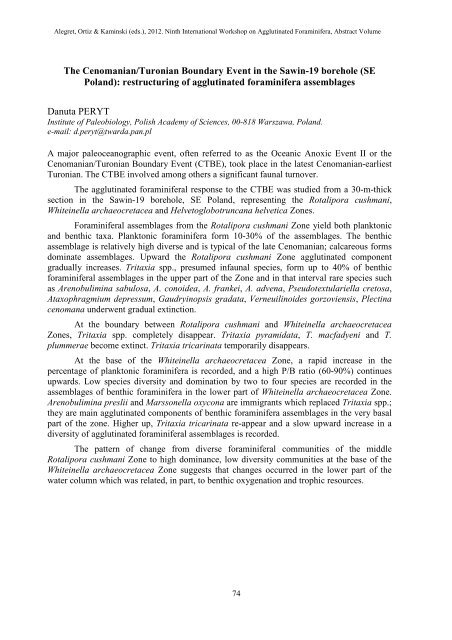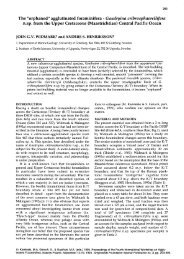Full Text | Download - Grzybowski Foundation - The ...
Full Text | Download - Grzybowski Foundation - The ...
Full Text | Download - Grzybowski Foundation - The ...
You also want an ePaper? Increase the reach of your titles
YUMPU automatically turns print PDFs into web optimized ePapers that Google loves.
Alegret, Ortiz & Kaminski (eds.), 2012. Ninth International Workshop on Agglutinated Foraminifera, Abstract Volume<br />
<strong>The</strong> Cenomanian/Turonian Boundary Event in the Sawin-19 borehole (SE<br />
Poland): restructuring of agglutinated foraminifera assemblages<br />
Danuta PERYT<br />
Institute of Paleobiology, Polish Academy of Sciences, 00-818 Warszawa, Poland.<br />
e-mail: d.peryt@twarda.pan.pl<br />
A major paleoceanographic event, often referred to as the Oceanic Anoxic Event II or the<br />
Cenomanian/Turonian Boundary Event (CTBE), took place in the latest Cenomanian-earliest<br />
Turonian. <strong>The</strong> CTBE involved among others a significant faunal turnover.<br />
<strong>The</strong> agglutinated foraminiferal response to the CTBE was studied from a 30-m-thick<br />
section in the Sawin-19 borehole, SE Poland, representing the Rotalipora cushmani,<br />
Whiteinella archaeocretacea and Helvetoglobotruncana helvetica Zones.<br />
Foraminiferal assemblages from the Rotalipora cushmani Zone yield both planktonic<br />
and benthic taxa. Planktonic foraminifera form 10-30% of the assemblages. <strong>The</strong> benthic<br />
assemblage is relatively high diverse and is typical of the late Cenomanian; calcareous forms<br />
dominate assemblages. Upward the Rotalipora cushmani Zone agglutinated component<br />
gradually increases. Tritaxia spp., presumed infaunal species, form up to 40% of benthic<br />
foraminiferal assemblages in the upper part of the Zone and in that interval rare species such<br />
as Arenobulimina sabulosa, A. conoidea, A. frankei, A. advena, Pseudotextulariella cretosa,<br />
Ataxophragmium depressum, Gaudryinopsis gradata, Verneuilinoides gorzoviensis, Plectina<br />
cenomana underwent gradual extinction.<br />
At the boundary between Rotalipora cushmani and Whiteinella archaeocretacea<br />
Zones, Tritaxia spp. completely disappear. Tritaxia pyramidata, T. macfadyeni and T.<br />
plummerae become extinct. Tritaxia tricarinata temporarily disappears.<br />
At the base of the Whiteinella archaeocretacea Zone, a rapid increase in the<br />
percentage of planktonic foraminifera is recorded, and a high P/B ratio (60-90%) continues<br />
upwards. Low species diversity and domination by two to four species are recorded in the<br />
assemblages of benthic foraminifera in the lower part of Whiteinella archaeocretacea Zone.<br />
Arenobulimina preslii and Marssonella oxycona are immigrants which replaced Tritaxia spp.;<br />
they are main agglutinated components of benthic foraminifera assemblages in the very basal<br />
part of the zone. Higher up, Tritaxia tricarinata re-appear and a slow upward increase in a<br />
diversity of agglutinated foraminiferal assemblages is recorded.<br />
<strong>The</strong> pattern of change from diverse foraminiferal communities of the middle<br />
Rotalipora cushmani Zone to high dominance, low diversity communities at the base of the<br />
Whiteinella archaeocretacea Zone suggests that changes occurred in the lower part of the<br />
water column which was related, in part, to benthic oxygenation and trophic resources.<br />
74



